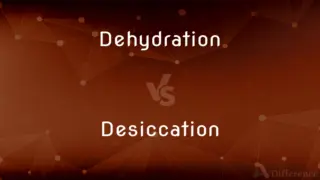Kerning vs. Tracking — What's the Difference?
By Tayyaba Rehman & Urooj Arif — Updated on May 5, 2024
Kerning adjusts the space between specific pairs of characters for a visually pleasing result, whereas tracking alters the spacing uniformly across a range of text.
Difference Between Kerning and Tracking
Table of Contents
ADVERTISEMENT
Key Differences
Kerning is applied to specific pairs of characters to correct spacing issues that can make certain letter combinations look awkward, such as 'AV', whereas tracking is applied uniformly across a section of text to affect overall text density and readability.
The main goal of kerning is to improve the visual cohesiveness of words, making them easier to read and more aesthetically pleasing, while tracking adjusts the general character density, which can enhance or detract from readability depending on how it's used.
Kerning often requires more precision and is typically adjusted by designers who are focusing on the look of individual words or short phrases, on the other hand, tracking adjustments are usually more about the legibility and overall appearance of paragraphs or larger blocks of text.
Over-kerning can make text look cramped and illegible, whereas excessive tracking can lead to text that feels sparse and disconnected.
Kerning adjustments are particularly crucial in large headings and logos where the relationships between letters are highly visible, whereas tracking is often adjusted in body text to achieve a uniform appearance or to fit more text into a given space.
ADVERTISEMENT
Comparison Chart
Definition
Adjusts the spacing between specific pairs of characters
Adjusts the spacing uniformly across larger text blocks
Purpose
To correct visual spacing issues between specific pairs
To change text density and impact overall readability
Application
Typically used in headlines, logos, and titles
Used across paragraphs and pages for consistency
Impact
Affects the appearance of words at a micro level
Affects the legibility and layout at a macro level
Typical Adjustment
Small, precise changes
Broader, more uniform changes
Compare with Definitions
Kerning
Adjusts space between specific character pairs.
Kerning is often adjusted between 'T' and 'o' to prevent visual disconnect.
Tracking
Affects large text blocks.
Uniform tracking helps maintain consistency in multi-page documents.
Kerning
Can be manually or automatically adjusted.
Most modern design software offers automatic kerning settings.
Tracking
Can be set for specific aesthetic effects.
Loose tracking is often used in artistic typography to create airy text.
Kerning
Is crucial for high visibility texts.
Kerning ensures that large print texts like billboards are clear and legible.
Tracking
Involves adjusting letter-spacing uniformly.
Tracking adjustments are crucial in the design of book typesetting.
Kerning
Focuses on pairs for aesthetic balance.
Kerning fixes awkward gaps that might appear in certain font pairings.
Tracking
Enhances or reduces text density.
Increasing tracking in a tight text block can enhance readability.
Kerning
Affects legibility and design of words.
Good kerning is crucial in professional typography and logo design.
Tracking
Applied to adjust the overall appearance.
Tracking is adjusted to fit more characters into a given format in newspapers.
Kerning
In typography, kerning is the process of adjusting the spacing between characters in a proportional font, usually to achieve a visually pleasing result. Kerning adjusts the space between individual letterforms, while tracking (letter-spacing) adjusts spacing uniformly over a range of characters.
Tracking
The placing of students in any of several courses of study according to ability, achievement, or needs. Also called ability grouping.
Kerning
The portion of a typeface that projects beyond the body or shank of a character.
Tracking
The position of a magnetic tape as it moves across magnetic heads, as in a VCR.
Kerning
To provide (type) with a kern.
Tracking
The lateral pressure of a phonograph needle as it tracks in a groove.
Kerning
To adjust space between (characters) in typeset text.
Tracking
The act or process by which something is tracked.
Kerning
(typography) The adjustment of the horizontal space between selected pairs of glyphs in a typeface.
Tracking
(typography) A consistent adjustment of space between individual letters; letterspacing.
Kerning
Present participle of kern
Tracking
(education) The division of pupils into separately taught groups by perceived ability level.
Tracking
Present participle of track
Tracking
The pursuit (of a person or animal) by following tracks or marks they left behind
Common Curiosities
Can kerning and tracking be adjusted in all software
Most typography and design software support both, but the extent and ease of adjustment can vary.
Is tracking useful for all types of text
Yes, especially in full paragraphs or pages where uniform text density is needed.
Why might a designer adjust tracking in a document
To improve the readability or fit text into a specific space more effectively.
How do kerning and tracking contribute to branding
Proper use ensures clear, readable, and visually appealing text that supports brand identity.
When should kerning be prioritized over tracking
In headlines, logos, and any place where the visual relationship between specific letters is crucial.
What impact does poor kerning have on text
It can make text look awkward and hard to read, impacting the professional quality of the design.
Can excessive tracking affect readability
Yes, too much tracking can create a disjointed reading experience by spacing the letters too far apart.
How does kerning affect logo design
It improves the readability and aesthetic of a logo by fine-tuning the space between characters.
What is the primary difference between kerning and tracking
Kerning adjusts space between pairs of letters, while tracking adjusts spacing uniformly across a text block.
Should tracking adjustments consider the typeface used
Yes, different typefaces respond differently to tracking adjustments, affecting overall aesthetics and readability.
Share Your Discovery

Previous Comparison
Fort vs. Castle
Next Comparison
Dehydration vs. DesiccationAuthor Spotlight
Written by
Tayyaba RehmanTayyaba Rehman is a distinguished writer, currently serving as a primary contributor to askdifference.com. As a researcher in semantics and etymology, Tayyaba's passion for the complexity of languages and their distinctions has found a perfect home on the platform. Tayyaba delves into the intricacies of language, distinguishing between commonly confused words and phrases, thereby providing clarity for readers worldwide.
Co-written by
Urooj ArifUrooj is a skilled content writer at Ask Difference, known for her exceptional ability to simplify complex topics into engaging and informative content. With a passion for research and a flair for clear, concise writing, she consistently delivers articles that resonate with our diverse audience.
















































